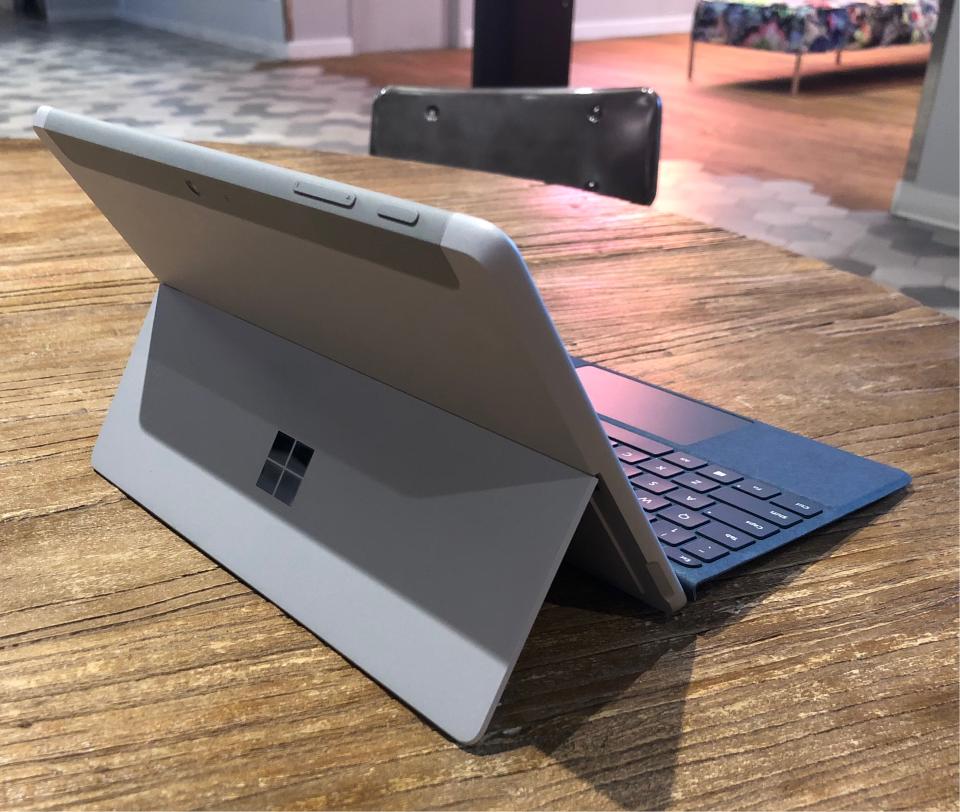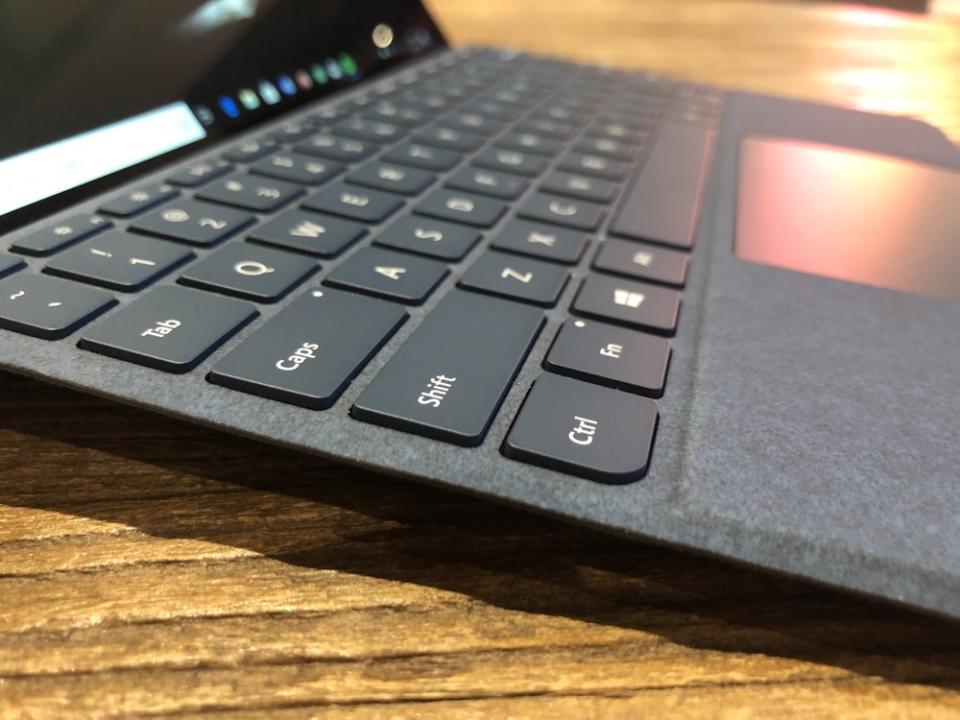Microsoft Surface Go review: A pint-size PC for getting work done
Microsoft’s (MSFT) Surface line of products has been a continuous bright spot for the company ever since it transitioned from Windows 8 to Windows 10. The Surface 3 and Surface Pro were fantastic tablet-laptop hybrids, and the Surface Laptop is a sleek notebook. Meanwhile, the Surface Book is an impressive powerhouse of a PC.
But Microsoft’s offerings weren’t inexpensive. Until now, that is. Meet the Surface Go, a $399, 10-inch version of the Surface tablet that’s meant to be your, well, on-the-go machine. Commuting to work? Taking a flight? Heading to class? This is the hybrid Microsoft believes can take on Apple’s (AAPL) iPad Pro and Google’s (GOOG, GOOGL) various Chromebooks.
And it does so admirably. The Surface Go can run a full desktop version of Windows 10 and offers the kind of fit and finish you’d expect from a Surface device. But the Surface Go isn’t perfect. Its keyboard is a bit too cramped for my liking, and if you want to do anything that requires serious performance, you’re out of luck.

The mini Surface
Microsoft’s Surface division makes some of the best products ever to sport the company’s logo. The brand’s trademark austere design, Alcantara soft-touch keyboards and, of course, the built-in kickstand for its 2-in-1 laptop-tablet hybrids, make for some attractive and useful devices. And all of that is present in the Surface Go.
It’s as if Microsoft’s head of hardware Panos Panay somehow got a hold of the shrink ray from “Honey I Shrunk the Kids” and decided to skip the kids part and just shrink the 12.3-inch Surface Pro.

There are a handful of notable differences. The edges of the Go are just a touch more rounded than those found on the Surface Pro. There’s also, mercifully, a USB C port. The Surface Pro still comes with a full-size USB port, which, at this point, is blasphemous. Especially, when you’re buying a device that starts at $799.
Outside of that, the Surface Go sports the same vibrant PixelSense display found on the Surface Pro, meaning you’ll get brilliant colors and sharp features out off the 10-inch panel. In other words, downsizing the Surface doesn’t mean you’re getting a subpar visual experience.
Smaller isn’t always better
But using Windows in desktop mode on a 10-inch tablet can also be a pain. For example, my father, who doesn’t have the best vision, would have trouble viewing text on the slate. It’s not something most people will run into, but it’s definitely worth taking into account.
In fact, I found the slate to be the perfect size for watching movies on the bus and in the car. It’s also just about the right size to prop up on my belly while catching up on “The Bachelorette” in bed.
My one complaint with the Surface Go’s size is its keyboard. Like the Surface Pro, the Go doesn’t come with a keyboard. Instead, you have to shell out an extra $99 on a basic Surface Type Cover or $129 for a Surface Go Signature Type Cover complete with soft-touch Alcantara. And you’re going to need that keyboard to use many of the Microsoft Store apps on the Surface Go.

As far as usability, though, the Surface Go’s keyboard is on a par with most Surface keyboards. There’s a good amount of key travel and the angle at which it sits when magnetically connected to the Surface is pleasant. But there’s a learning curve when it comes to typing on this pint-size puppy.
When I first began using the Surface Go’s keyboard, I regularly found myself mistyping words or pressing the caps lock button when I wanted to press the “A” key. Over time, though, I became more comfortable with the keyboard and fell right back into my normal touch-typing habit. My advice is if you have larger hands, or sausage-like fingers like me, you’ll want to try the Surface Go Type Cover before making your purchase.
Portable, not powerful
With only so much room inside to pack a processor, storage and RAM, Microsoft couldn’t pack the latest and greatest processor into the Surface Go. Instead, the tech giant equipped the small slate with an Intel Pentium Gold processor. That’s not going to give you the kind of performance you’d expect out of a Core i5, or even Core i3 processor.
That’s not to say that the Go crawls. On the contrary, I was able to have multiple tabs open in Microsoft’s Edge browser, while running Spotify, streaming Netflix and chatting on Slack without running into a problem. That said, don’t expect to play any games on this thing outside of basic tablet games.
But the Surface Go comes loaded with Microsoft’s Windows 10 in S mode, which limits you to only downloading apps from the company’s own Microsoft app store. That means you’ll end up using the tech giant’s Edge web browser rather than Google’s Chrome. You’ll get the best performance out of the Go when it’s in S mode, since the hybrid was specifically designed to work with it. But if you want to branch out to different programs, you can always switch to full Windows mode.

The process takes less than five minutes and doesn’t even require a system restart. I didn’t even notice the change over, and I was staring at the Go the whole time.
But Google’s Chrome is a resource hog. When I went back to browsing with several tabs open, while streaming Spotify and Netflix and chatting on Slack, I began to notice performance issues with the Go. Specifically, websites, especially image-heavy sites like Polygon.com and our own Yahoofinance.com began to load more slowly.
It’s important to note that my test machine came with 8GB of RAM, which is an upgrade from the base model of the Go which starts at $399. That upgrade will cost you, though, as the 8GB model starts at $549, plus thee extra $99 for the base keyboard.
Still, the fact that the Go gives you the ability to use full desktop apps makes it more useful than any Chromebook or Apple’s iPad Pro.
Should you get it?
I rank the Surface Go above the iPad Pro and any of Google’s Chromebooks when it comes to overall productivity. The iPad Pro’s keyboard isn’t nearly as good as the Surface Go’s, despite its size, and Chromebooks can’t run full desktop apps. As a straight-up tablet, the Pro wins, but that’s not why you buy a Pro to begin with.
I wouldn’t recommend that you purchase the Surface Go as your primary device, though. This is a machine meant for use as a secondary PC you can quickly get work done on and then go back to watching Hulu — which is exactly what I’m going to do now.
Disclosure: The writer’s spouse works for a public-relations agency that contracts with Microsoft’s Xbox division.
More from Dan:
Facebook’s Sheryl Sandberg reveals details of sophisticated disinformation campaign
Microsoft earnings beat expectations as cloud business booms
Email Daniel Howley at [email protected]; follow him on Twitter at @DanielHowley. Follow Yahoo Finance on Facebook, Twitter, Instagram, and LinkedIn
